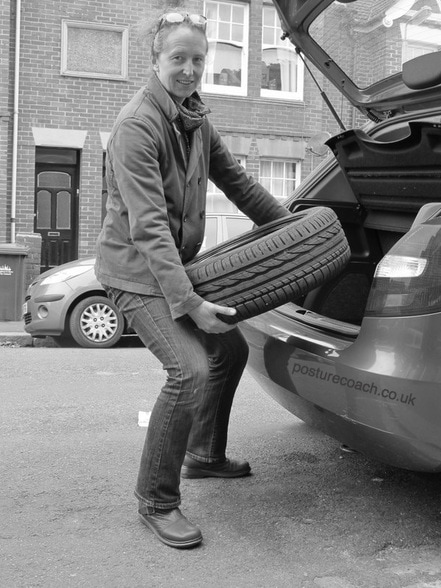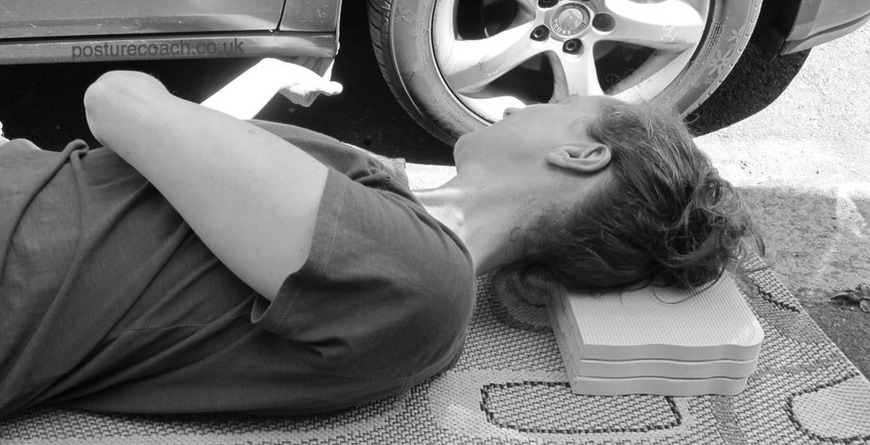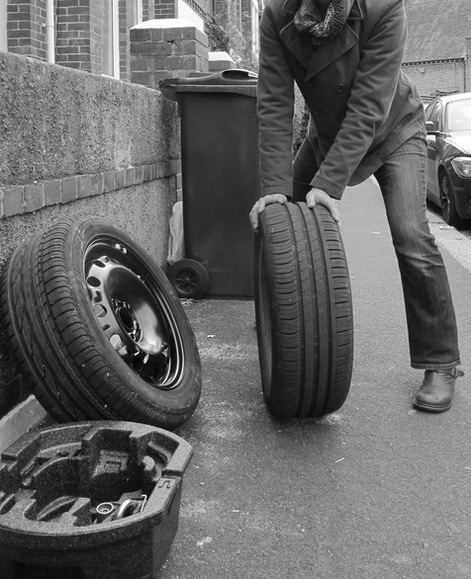
posturecoach
Easy does it
Sarah's posturecoach Guide to
Changing a Wheel.
So stuff happens, like that distinct hissing sound that only a rapidly deflating car tyre can make, and there we have it.......something else to deal with!
Stop and think.
How we respond to situations can make a huge difference in life. It's easy to feel stressed, frustrated or annoyed, but generally this doesn't make things any better. So take time to weigh up your options. If you have a flat tyre the best thing to do is probably call a breakdown service and get them to sort it out.
Failing that if you're at home see if you can find someone for whom changing a car wheel is well within their normal capability.....It's time to call in a favour or two! If you're not used to lifting a heavy spare-wheel out of car boot then I strongly recommend that you avoid doing so. The potential for strain and injury is considerable and it's really not worth the risk of incapacitating yourself. Making a decision not to do something is often the most important thing you can do.
Go easy.
Having taken on board the above advice you may decide that you are capable of tackling the job yourself. If this is the case you definitely want to make sure that you go easy and avoid any possibility of straining or injuring yourself in the process. Read on for tips to help you to complete the task with the maximum of ease and efficiency. (Do also check your car manufacturer's advice in your car hand-book including all health and safety guidance).
Think about where you bend.
You will need to lower yourself in height in order to be on the same level as both your spare wheel and your punctured tyre. Bending at the hips, knees and ankles rather than at your waist or back can be helpful in reducing the risk of placing damaging strain on your back and spine.
Use balance to your advantage
Have your feet firmly on the ground and a suitable distance apart to provide stable support. By counter-balancing your own weight against that of the spare wheel it is possible to hold the weight of the wheel securely with reduced risk of toppling and straining yourself.
Changing a Wheel.
So stuff happens, like that distinct hissing sound that only a rapidly deflating car tyre can make, and there we have it.......something else to deal with!
Stop and think.
How we respond to situations can make a huge difference in life. It's easy to feel stressed, frustrated or annoyed, but generally this doesn't make things any better. So take time to weigh up your options. If you have a flat tyre the best thing to do is probably call a breakdown service and get them to sort it out.
Failing that if you're at home see if you can find someone for whom changing a car wheel is well within their normal capability.....It's time to call in a favour or two! If you're not used to lifting a heavy spare-wheel out of car boot then I strongly recommend that you avoid doing so. The potential for strain and injury is considerable and it's really not worth the risk of incapacitating yourself. Making a decision not to do something is often the most important thing you can do.
Go easy.
Having taken on board the above advice you may decide that you are capable of tackling the job yourself. If this is the case you definitely want to make sure that you go easy and avoid any possibility of straining or injuring yourself in the process. Read on for tips to help you to complete the task with the maximum of ease and efficiency. (Do also check your car manufacturer's advice in your car hand-book including all health and safety guidance).
Think about where you bend.
You will need to lower yourself in height in order to be on the same level as both your spare wheel and your punctured tyre. Bending at the hips, knees and ankles rather than at your waist or back can be helpful in reducing the risk of placing damaging strain on your back and spine.
Use balance to your advantage
Have your feet firmly on the ground and a suitable distance apart to provide stable support. By counter-balancing your own weight against that of the spare wheel it is possible to hold the weight of the wheel securely with reduced risk of toppling and straining yourself.
Bring yourself down to the level you need to work at.
Many people find lessons in the Alexander Technique helpful for improving mobility and flexibility in joints such as the hips, knees and ankles. Alexander work uses gentle mind-muscle training as opposed to stretching or physical exercise routines. It is a long term approach rather than a quick fix but can be extremely effective.
Many people find lessons in the Alexander Technique helpful for improving mobility and flexibility in joints such as the hips, knees and ankles. Alexander work uses gentle mind-muscle training as opposed to stretching or physical exercise routines. It is a long term approach rather than a quick fix but can be extremely effective.
Use gravity and leverage to your advantage.
You shouldn't need to use physical strength or excessive effort to loosen the nuts on your wheel. Using your own body weight, balance, gravity and the leverage of your wrench allows for the minimum of effort and exertion.
You shouldn't need to use physical strength or excessive effort to loosen the nuts on your wheel. Using your own body weight, balance, gravity and the leverage of your wrench allows for the minimum of effort and exertion.
Look after your head.....and neck.
Did you know that the average adult human head weighs 10-11lbs or approximately 5kgs? If you need to get horizontal on your back to look under your car, e.g. to check the location of your jack-point this can put immense strain on your neck. In this situation it's a good idea to use a support for your head such as some foam blocks. If you have neck, shoulder, back or joint pain then lessons in the Alexander Technique can often help to relieve these problems by teaching you how to release excessive muscle tension and how to improve your balance and muscle co-ordination.
Did you know that the average adult human head weighs 10-11lbs or approximately 5kgs? If you need to get horizontal on your back to look under your car, e.g. to check the location of your jack-point this can put immense strain on your neck. In this situation it's a good idea to use a support for your head such as some foam blocks. If you have neck, shoulder, back or joint pain then lessons in the Alexander Technique can often help to relieve these problems by teaching you how to release excessive muscle tension and how to improve your balance and muscle co-ordination.
Think it through.
Remember, don't rush. Give yourself time to think about how you are going about your task. Think through the options and make considered choices. Why carry that heavy wheel when you can roll it instead? Most importantly, if in doubt get someone else to do the whole job for you. You might also choose to invest in a course of lessons in the Alexander Technique. The Technique helps you to go about any activity with more ease and less chance of strain and pain, whether you're changing a car wheel, playing a musical instrument, coping with increasing demands at work or picking up a bag of shopping.
Contact [email protected] for more details.
Remember, don't rush. Give yourself time to think about how you are going about your task. Think through the options and make considered choices. Why carry that heavy wheel when you can roll it instead? Most importantly, if in doubt get someone else to do the whole job for you. You might also choose to invest in a course of lessons in the Alexander Technique. The Technique helps you to go about any activity with more ease and less chance of strain and pain, whether you're changing a car wheel, playing a musical instrument, coping with increasing demands at work or picking up a bag of shopping.
Contact [email protected] for more details.
Note:
The opinions expressed in this feature are my own personal opinions and do not necessarily represent the views of other Alexander Teachers or organisations.
The opinions expressed in this feature are my own personal opinions and do not necessarily represent the views of other Alexander Teachers or organisations.
"Moving in tight spaces, lifting and gripping......Being able to apply the Alexander Technique to these occasions has helped put less strain on my body."
Nick Pynn
Nick Pynn
For enquiries contact Sarah on 079 497 483 14 or email [email protected]







